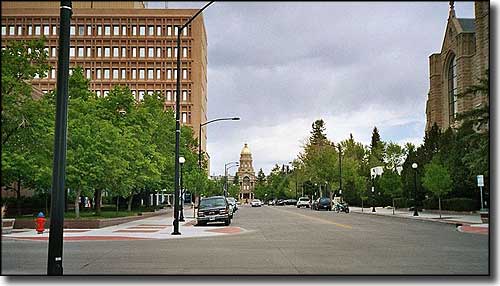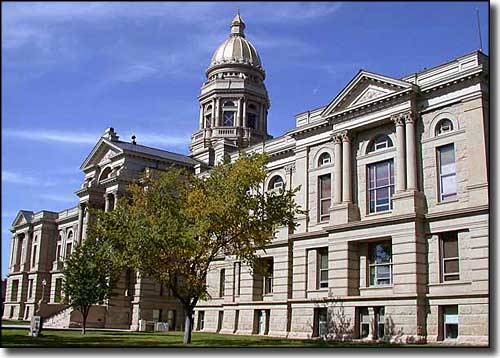
Cheyenne, Wyoming

Capitol Avenue in Cheyenne
The survey crew of General Grenville M. Dodge first platted the site of Cheyenne in Dakota Territory on July 4, 1867. The area was previously known as "Crow Creek Crossing" but was renamed in honor of the Cheyenne Nation, one of the fiercest tribes on the Great Plains and close allies of the Arapaho. As the Cheyenne were very much against the advance of the railroad (and the changes it would bring), this was a half-hearted attempt at placating them.
Because the plan was for Cheyenne to be on the Transcontinental Railroad line, by the time the tracks arrived the following November there were already more than 4,000 residents of the new city. Some of these folks moved on with the railroad as it worked its way west but they were more than replaced by incoming business men, displaced cowboys, saloon owners, gamblers, thieves, prostitutes and downright opportunists. The army built Camp Cheyenne just outside the city limits, then renamed it Fort D.A. Russell, and much later rechristened it as F.E. Warren Air Force Base.
As Cheyenne was the only settlement of substance in the newly declared Wyoming Territory, it was the designated capital and primary center of commerce. However, back in those days, that also meant "center of political corruption" (see Johnson County War).
The first telephone directory in the United States was published by the Wyoming Telephone and Telegraph Company in Cheyenne in 1881. Because of a shortage of white paper, it was printed on yellow paper. That's how the whole yellow pages tradition got started.
Cheyenne Frontier Days, an annual event held during the last week of July, is the largest outdoor rodeo on Earth and attracts more than 30,000 tourists to the rodeo, carnival, gunslinger exhibitions, historic tours and other features and events.

Wyoming State Capitol building in Cheyenne
Zip Codes: 82001-82003, 82006-82010
Latitude: 41.1455°N
Longitude: 104.802°W
Founded: 1867
Elevation: 6,062'
Education:
High School or Higher: 89.0%
Bachelor's Degree or Higher: 24.5%
Graduate or Professional Degree: 8.5%
2011 Cost of Living Index for Cheyenne: 83.4
Estimated Median Household Income: $47,500
Estimated Median Home Value: $168,000
Median Resident Age: 36.6 Years
Population Density: 2,661 People per Square Mile
Major Industries:
Government, Construction, Health Care, Lodging & Food Services, Educational Services, Rail Transportation, Professional Services, Social Services
Unemployed (March 2011): 6.6%
Population Demographics: 2010
| Total Population | 59,466 |
| Males | 29,330 |
| Females | 30,136 |
| Population by Age | |
| Under 18 | 14,260 |
| 18 & over | 45,206 |
| 20-24 | 4,197 |
| 25-34 | 8,705 |
| 35-49 | 11,423 |
| 50-64 | 11,428 |
| 65 & over | 8,036 |
| Population by Ethnicity | |
| Hispanic or Latino | 8,594 |
| Non Hispanic or Latino | 50,872 |
| Population by Race | |
| White | 51,999 |
| African-American | 1,715 |
| Asian | 732 |
| Native American | 570 |
| Hawaiian or Pacific Islander | 118 |
| Other | 2,380 |
| Two or more | 1,952 |
Curt Gowdy State Park - Medicine Bow National Forest
